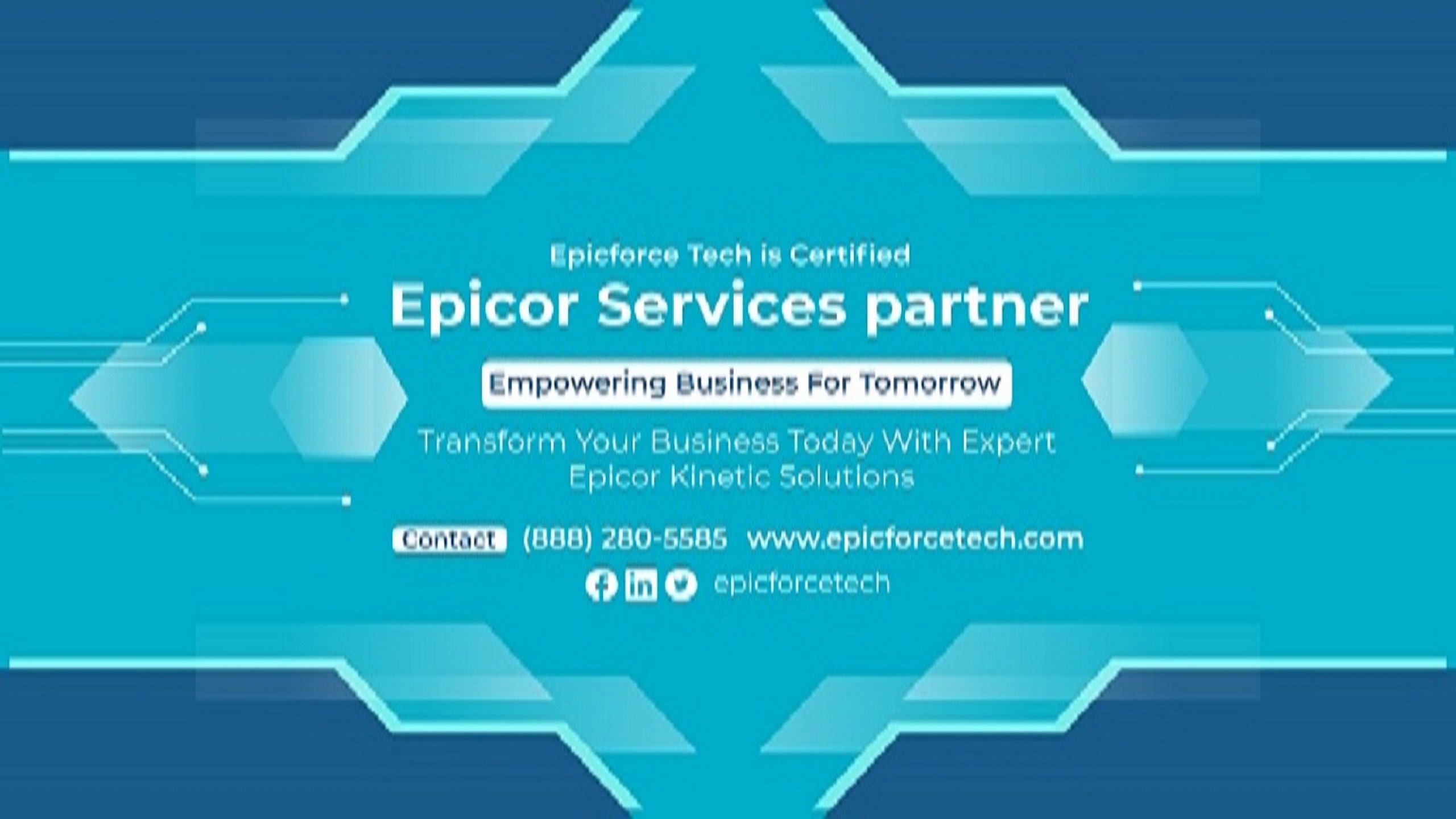Introduction
ERP systems like Epicor are powerful. However, when reporting falls short due to slow performance, inaccurate data, or confusing outputs, business operations can suffer. At Epicforce Tech, we often encounter companies who are frustrated with their Epicor reporting. Reports are either too slow, too rigid, or too difficult for decision-makers to understand.
This blog walks through how Epicor consultants identify and resolve reporting challenges, ensuring that your reports become a strategic asset instead of a source of daily friction.
Why Epicor Reporting Becomes Ineffective
Epicor offers robust reporting tools such as BAQs, dashboards, SSRS, and Excel Connect. Over time, however, reporting environments can break down. Common problems include:
-
BAQs that are inefficient or misaligned with business rules
-
SSRS reports that are outdated or overly complex
-
Users relying on manual workarounds instead of automation
-
Inconsistent use of fields, naming conventions, or filters
-
Excessive hardcoding in reports, which makes changes difficult
Without clear governance or expert review, these issues tend to grow and affect reliability, speed, and decision-making.
Step 1: Assess Your Current Reporting Landscape
The first step Epicor consultants take is to assess your reporting landscape. This includes identifying:
-
The number of active BAQs and SSRS reports
-
Reports that are no longer used but still running
-
Performance-heavy queries that slow the system
-
Reports with manual data dependencies such as spreadsheets
At Epicforce Tech, we also interview end users to understand pain points. Are reports not trusted? Are teams creating their own external reports because the system fails to deliver?
This step ensures that any cleanup aligns with how your team actually works, not just with system logs.
Step 2: Prioritize Reporting Pain Points
Once the inventory is complete, the next step is triage. Consultants group reports and queries based on:
-
Business-critical versus informational
-
Frequently used versus outdated
-
Slow-performing versus efficient
-
Trusted versus frequently questioned
By focusing on reports that impact daily operations, we prevent teams from wasting time chasing unreliable data or recreating reports manually.
Example priority matrix:
| Report Type | Usage Frequency | Issue Type | Action |
|---|---|---|---|
| Sales Performance | Daily | Too slow | Optimize BAQ |
| Aged Receivables | Weekly | Inaccurate figures | Validate data joins |
| Job Costing | Monthly | Not used anymore | Archive |
Step 3: Optimize BAQs for Speed and Accuracy
Business Activity Queries (BAQs) form the backbone of many Epicor reports. Poorly written BAQs can be the root cause of reporting issues.
Epicor consultants review the following:
-
Joins between tables to determine if they are efficient and necessary
-
Calculated fields to assess whether they should be handled in the report layer
-
Subqueries that may be bloating runtime
-
Filtering logic and where it is applied
At Epicforce Tech, we often restructure BAQs completely to improve performance and maintainability. Using temporary tables and Common Table Expressions (CTEs) strategically can also help.
Step 4: Review and Rationalize SSRS Reports
SSRS reports often suffer from being overly complex, especially if they have been modified many times without cleanup.
Our approach includes:
-
Checking for redundant datasets or embedded queries
-
Removing hardcoded parameters
-
Streamlining page rendering and output formats
-
Mapping each report’s data source back to clean BAQs or stored procedures
If multiple reports pull similar data, they can often be merged or standardized. This reduces maintenance and improves consistency across departments.
Step 5: Standardize Report Formats and Naming Conventions
A common issue in reporting is inconsistency. Report titles may be unclear, parameter prompts inconsistent, and column formats misaligned.
Consultants help define:
-
Naming conventions for reports and queries
-
Standard filters and date range prompts
-
Formatting rules for currency, decimals, and dates
-
Security roles for viewing or running specific reports
Standardization improves user trust and simplifies training for new employees.
Step 6: Validate Report Accuracy Against Source Data
Even fast, well-designed reports are ineffective if the numbers are wrong. Validation includes:
-
Comparing report output with transaction screens in Epicor
-
Reviewing BAQ joins to ensure proper use of table keys
-
Matching calculated fields with manual computations
-
Spot-checking recent data for timing or update issues
At Epicforce Tech, we emphasize data accuracy and involve both technical and business users in the validation process. It is essential that users trust what they see.
Step 7: Replace Manual Processes with Real-Time Dashboards
When Epicor reporting fails to deliver, teams often resort to manual Excel exports or spreadsheets. This introduces risks and inefficiencies.
Epicor consultants use dashboards to:
-
Deliver real-time views for sales, inventory, and financials
-
Reduce the need for emailed reports or printed documents
-
Create role-based visibility for users at different levels
-
Include graphs and filters for better usability
Dashboards are easier to maintain than SSRS reports and can refresh automatically, saving time and effort.
Step 8: Build a Reporting Governance Framework
Once reporting is cleaned up, keeping it efficient and reliable requires structure. A governance framework outlines:
-
Who can request new reports
-
Who owns and maintains each report
-
How changes are reviewed and tested
-
When old reports are retired or archived
Epicforce Tech often assists in creating documentation, version control workflows, and handover checklists to internal teams.
Step 9: Train Your Users to Use Reports Effectively
Even the best report is wasted if users do not understand it. Consultant-led training helps users:
-
Understand what each report is for
-
Use filters and run parameters correctly
-
Interpret key metrics
-
Know what to do when something looks incorrect
We recommend brief, role-based training sessions combined with guides or embedded instructions within dashboards.
Step 10: Monitor and Improve Continuously
Reporting needs evolve as business needs change. After the initial cleanup, consultants help set up:
-
Regular report audits
-
Usage tracking to find unused or duplicated reports
-
Feedback mechanisms for enhancement requests
-
Performance checks for large datasets
This ensures that the reporting environment continues to meet the needs of the business over time.
Final Thoughts
Epicor reporting issues are rarely caused by a single factor. They often result from inefficient queries, outdated templates, unclear processes, and a lack of user support.
At Epicforce Tech, our Epicor consultants use a step-by-step method to clean up reporting systems so that businesses can rely on their data and make better decisions.
With the right approach, reporting can shift from being a bottleneck to becoming a strategic advantage.
Need Help Cleaning Up Your Epicor Reporting?
We are here to help. Whether you need BAQ optimization, SSRS restructuring, or dashboard redesign, Epicforce Tech offers hands-on Epicor consulting to enhance your ERP reporting system.
Email: info@epicforcetech.com
Phone: (888) 280-5585
Website: epicforcetech.com






